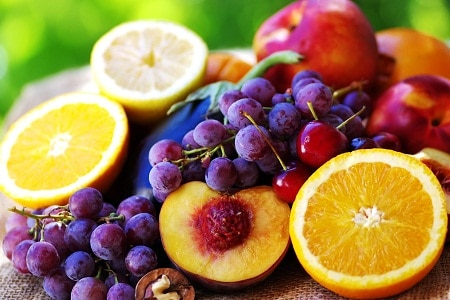by Andrew Pacholyk MS L.Ac
Peacefulmind.com
When eating along with the seasons, there are two elements that should be taken into account. The “nature” of the food and the “flavor” of the food. The nature of the food refers to the foods innate temperature ie: cold, hot, warm, cool or neutral. Eating a moderate amount of all flavors sweet, salty, pungent, bitter and sour can help to keep your body balanced and regulated.
Summer is actually divided into two categories. The early part of the summer is the transition from Spring to the Summer Solstice, the longest day of the year. As the summer wanes the real “dog days of summer” are considered the hottest and is called Late Summer.
In general, eating light and easily digestible foods is most important. Fruits and vegetables grow and are at their greatest peak, giving us an abundance of choices for eating the right way. It is particularly important to avoid overeating especially as the summer gets later. Therefore, heavy, greasy fried foods should be avoided as they tax the heart, small intestines, stomach and spleen. Foods that are cooling in nature are what the body craves.
Although the temptation for ice cold drinks, ice cream and other frozen treats seem to be appropriate, moderation is very important. Eating to much cold or raw foods can injure the spleen and stomach, cause headaches, upset digestion and slow metabolism.
Bitter taste is attributed to the heart and small intestine while sweet taste attunes to the spleen and stomach. Therefore, adding some bitter foods in your diet during early summer and more sweet tasting foods in late summer, can improve the body’s function. Consider watermelons, honeydew and cantaloupe. These fruits, in particular, have a tendency to clear summer heat, cool inflammation and benefit the Stomach. Juice therapy is a great way to take advantage of seasonal fruits and vegetables and get your daily nutrition. You might also consider drinking mint, chamomile and chrysanthemum teas.
Consider eating these food for Summer:
1. Foods that are more cooling in nature such as bamboo shoot, banana, bitter gourd, clam, crab, grapefruit, lettuce, persimmon, salt, seaweed, star fruit, sugar cane, water chestnut, watermelon, lotus root, cucumber, barley, bean curd, chicken egg white, marjoram, oyster, pear, peppermint, radish, strawberry, tangerine, and yogurt, broccoli, cauliflower, zucchini, corn, tomatoes, pineapple, turmeric.
2. Grilling is a big part of summer eating yet, grilling often dries the juices in food. If you grilled or fry meats in summer, serve them with cooling, moisturizing fruits and vegetables such as cucumber, kiwi, mango, papaya, pineapple and tomatoes. These fruits and vegetables can be lightly grilled or marinated in a side salad or side dish as they compliment the drying effects of grilled meats.
3. Keep food out of the sun. Direct sunlight causes the immediate loss of vital essences or vitamins and can spoil food. Consider keeping foods refrigerated until they are ready to be served, especially foods containing mayonnaise, oils, vinegar or sauces.
4.Enjoy vegetables such as bamboo, sprouts, bok choy, broccoli, Chinese cabbage, corn, cucumbers, mushrooms, snow peas, spinach, summer squash, water crest, seaweeds, potatoes, and Mung beans
5. Herbs, spices, condiments, oils such as cilantro, mint and dill.




